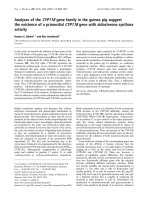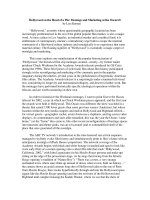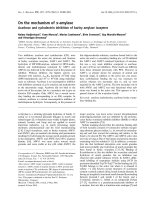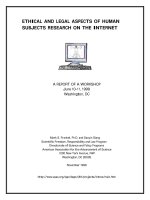Hollywood on the Head of a Pin: Montage and Marketing at the Oscars® docx
Bạn đang xem bản rút gọn của tài liệu. Xem và tải ngay bản đầy đủ của tài liệu tại đây (43.47 KB, 10 trang )
Hollywood on the Head of a Pin: Montage and Marketing at the Oscars®
by Lisa Kernan
“Hollywood,” an entity whose questionable geographic location has been
increasingly problematized in the era of the global popular film market, is also a magic
word. At once a place in Los Angeles, an industrial marker and a mythical land, it is
emblematic of contemporary cinema’s contradictory urge both to escape the material
constraints of a film-based culture industry and nostalgically to re-experience that same
material culture. The floating signifier of “Hollywood” is essentially a magic carpet of
nostalgia and marketing.
This essay explores one manifestation of the popular historicization of
“Hollywood,” the historical film clip montages created—mostly—by former trailer
producer Chuck Workman for the Academy Awards telecasts produced by Gil Cates
during the 1990s. These brief pieces of (televised) film about film history participated
strongly in the reconfiguring and marketing of the cinematic past in the popular
imaginary during the nineties, pivotal years in the globalization of hegemonic American
film culture. The Academy Awards telecast is a surprisingly under-examined televisual
text, considering its longevity and international ubiquity, and deserves further work. But
the montages have performed historically specific ideological operations within the
telecast, and are worth examining on their own.
In order to historicize the Workman montages, I want to point first to the Oscars
telecast for 2002, a year in which no Chuck Workman pieces appeared, and the first year
the awards were held in Hollywood. This Oscars was different: the show was held in a
theater that seated 1500 fewer guests than some previous venues (Anderton), but whose
location within the new media complex and mall at Hollywood and Highland offered—
for virtual guests—geographic cachet, ersatz Intolerance elephants, and big-screen video
displays. As commentators and stars alike remarked, this was the year the Oscars “came
home,” yet the “home” they came to, like other recent reconfigurations of heritage spaces
into museums and theme parks, was an eviscerated (and re-commodified) shell of the
place that once generated all the nostalgia.
The ABC TV network’s introduction to the time-honored star arrival sequence
managed to stylishly evoke film history and simultaneously point to film’s future with an
anticipatory nostalgia of Blade Runner proportions. The network coverage of the
Academy Awards begins with black and white footage (scratched and aged to look like
worn early film) of a curtain opening onto a silent film title that reads “Hollywood,
California, 2002,” with John Leguiziamo (in his Moulin Rouge persona and make-up)
sitting on the edge of the proscenium stage. As he sings (borrowing from the Moulin
Rouge opening’s rendition of “Nature Boy”): “There was a town, a very strange
enchanted town, where stars shine up instead of down, what a town, built on fantasy…”
the camera shows an aerial extreme long shot of Hollywood (akin to the one of Paris
from Moulin Rouge), then zooms hyperbolically through and into the Hollywood space
(again like the Moulin Rouge opening) and into the environs of the Hollywood and
Highland mall complex housing the Kodak Theater, where we see that the shots of
buildings on Hollywood Boulevard have been digitally papered over with posters from
classical Hollywood films. The sweeping camera eventually lands on the ABC
commentator who introduces the star arrival sequence by waxing on about the show’s
new Hollywood location.
This hyperbolic collapsing of film-historical specificity within a spatially-based
and marketing-driven, postmodern nostalgia bath on live TV is only possible in the
digital media environment. The 2002 Oscar show introduction performs a mapping of
first, a visual and aural take-off on a current film, and next, old movie posters, onto the
contemporary Hollywood street, collapsing cinematic space onto at once marketing
discourse and geographic space. Such “presti-digital” cinematic feats point to new
geographies of movie marketing, and more precisely, movie heritage marketing, that have
broader implications. As recent conjunctions of media studies and cultural geography
have made clear, investigations of “MediaSpace” can yield “geographically informed and
spatially sensitive” analytical techniques with the potential to shed new light on “forms of
inequality and dominance, knowledge and practice.” (Couldry and McCarthy, 4)
Contemporary movie marketing is ripe for such analyses.
For some time now, movie marketing has expanded its boundaries beyond discrete
paratexts such as posters, TV ads, trailers, or featurettes, and into such publicity-driven
entities such as “Entertainment News” shows, actual news segments covering movie
premieres or milestones, and other nebulous promotional venues. The digital environment
accelerates such embedments and boundary-crossings. Marketing becomes an
increasingly elusive and crucial subject for film historians interested in ecologies of
cinematic knowledge. The current phenomenon of digital media about film history owes
much to the Oscar show’s use of montage, and particularly its use of Workman’s series of
film history montages of the 1990s.
The Academy Awards have been broadcast on television since 1953, when the
show was sponsored by RCA Victor and televised by NBC. (Levy, 24) The show is
currently contracted to the ABC network and has consistently captured very large
audiences. The impact of Academy Awards on films and their creators has been widely
discussed. As Emanuel Levy notes,
[W]inning an Oscar means not only prestige but hard cash at the box office. Winning the Best Picture
award can add up to twenty or thirty million dollars in movie ticket sales. … Significantly, the Oscar’s
effects have been visible in both the domestic and international film markets: the box-office receipts of
movies abroad at times amount to more than half of their overall profits. … [W]inning artists also gain
power in negotiating for better roles with better directors, and earn increased popularity outside the film
industry and outside of the U.S. (Levy, 45)
The Academy Awards telecasts’ preeminent figuration each year of a televisual
discourse promoting popular American film culture to a global audience is characterized
by Toby Miller et al., in Global Hollywood as “advocacy marketing.” The Oscars, like
other awards shows, film festivals and trade shows,
aim to build positive brand awareness, popular acclaim and formal political support for the major
Hollywood distributors. The brand or trademark is a form of symbolic equity that can be accumulated
through regular advocacy, giving major distributors a ‘trademark advantage’ over newcomers. (Miller et al.,
161)
The Oscar telecast is thus a crucial marketing tool for the consolidation of the globalized
American film industry’s hegemony.
Aside from the promotional effects of specific film clips and star visibility, the
Oscar show’s many paeans to Hollywood history over the years, of which the Workman
montages are in the forefront, also contribute to an overall marketing of the activity of
watching movies. In the process, ideological and even epistemological assumptions as to
what that activity entails are marketed as well.
Like trailers for individual films, these “trailers” for film history (made by a former
trailer-maker) use a montage structure which both elides and reconfigures the narrative
they promote. When that “narrative” is the entire history of Hollywood cinema—indeed
world cinema mapped onto Hollywood cinema under the rubric of “the movies”—as
summed up within a brief montage of very short clips, the ideology of cinematic
representation as a magic act is overdetermined and foregrounded, bringing it in line at
once with other advertising rhetoric (Williamson 140-145) and with that of the circus
sideshow. Much of the appeal of these montages is the impossible task they attempt: all
of film history in four minutes! Like the pre-cinematic appeal of miniaturization-based
attractions, such as the Declaration of Independence or Gettysburg Address on the head
of a pin, they astound by condensing, rendering the texts of history—here, fragments of
film history—available for inspection by an audience flattered with the illusion of a god-
like, all-encompassing, and since temporality is also involved in this case, rapidly
assimilating gaze.
Susan Stewart has argued that the appeal of miniature writing, specifically of the
miniature book, coincided with the transition from one technology to another (with the
invention of printing):
On the interface between the manuscript and printing, the miniature book is a celebration of a new
technology, yet a nostalgic creation endowed with the significance the manuscript formerly possessed.
(Stewart, 39)
The appeal of the excess rapidity of these montages likewise redoubles a nostalgic
immersion in cinema’s past, by way of the new media discourses of the millennial
globalized “Hollywood,” precisely at the interface between the cinematic and the post-
cinematic eras. Examining the ways montage is called into service for such marketing
purposes has the potential to contribute to current explorations of the role of film
historiography in the information age.
The first credited Chuck Workman montage shown during an Oscar telecast was
for the 62nd Academy Awards in 1990, not long after Workman won an Oscar and
critical acclaim for his 1986 DGA-commissioned short, Precious Images, which
pioneered the rapid-fire film history montage. Specially introduced and credited (“by
Academy Award-winning filmmaker Chuck Workman”), the Oscar piece, entitled “100
Years at the Movies,” set the precedent for a number of similar celebrations throughout
the nineties telecasts, usually presented early in the show. (Montages were rarely featured
in earlier telecasts, and indeed the clips from nominated films were usually single extracts
until the ‘90s.) 1991’s montage depicted stars remembering their first times at the movies.
The following (64th) Oscars had a montage of “laughs… from movies that still bring joy
to the world.” Both were announced as Workman films.
Several Oscar shows during the decade presented themed montages by other
filmmakers, on women in cinema (by Lynne Litman), the work of the cinematographer,
and on the activity of going to the movies (by Mike Shapiro and John Bloom respectively,
both uncredited). The 67th show (1995) presented a tribute to comedy that incorporated a
credited Workman montage with a dance number where onstage stars interacted with the
screen. And Workman montages were highlighted in the 70th through 72nd shows (1998-
2000), on Oscar acceptances, “great moments,” and history in film. Interestingly, Jack
Valenti and other “leaders of the Hollywood morale effort” also enlisted Workman into
the industry’s post-September 11 war support when he created (for producer Michael
Rhodes) a trailer for patriotism called “The Spirit of America,” that was shown on “one-
fourth of the nation’s movie screens by Christmas day,” 2001, and for which he selected
clips from “movies that had something to say about being an American” (Lyman).
I focus here on a description of the first, 1990 montage, which originates the format,
utilizing many of the clips from Precious Images and establishing conventions for
subsequent montages. It followed an almost giddy opening speech by Academy president
Karl Malden emphasizing the newly global reach of the satellite-assisted Academy
Awards telecast (the previous year was the first time it was seen in Russia): “How can
you have a closed society when the skies are open from Moscow to Beijing to—you
name it—Gary, Indiana?” In that context, Malden introduces Workman’s “special
tribute” as a “magic look back at all the yesterdays that have brought us up to today.”
The “100 Years” montage, like its successors, is structured to flow from one loose
category of filmic examples to another, assisted by musical cues, while continually
rupturing the categories with clips that fit rhythmically but not thematically. The montage
moves broadly from an introduction accompanied by the alien musical motif from Close
Encounters of the Third Kind, to a focus on early cinema, to a survey of action genres
accompanied by a familiar piano “chase” motif, to a horror and fantasy segment (set to
the “Ghostbusters” theme), to a brief segment highlighting gender-bending, to one
emphasizing musicals and slapstick comedy choreographed to a polka theme, to a
romance-oriented segment set to the Love Story theme. It then moves into spectacles,
such as explosions and death scenes from war films, set to a dramatic choral motif, with a
highlight on Tom Joad’s “I’ll be there” speech followed by a string of images of heroes
(mostly male) in action, then a string of women’s faces, then a climactic series of varied
images which ends with the clinch scene from Moonstruck followed a shot of Peter
O’Toole blowing out a match in Lawrence of Arabia, set to the “Close Encounters”
theme. Workman’s compilation contains approximately 45 clips from non-Hollywood
films, about a tenth of the total.
While this and the other Workman montages ultimately elude any causally or
narratively-based rhetorical analysis as persuasive marketing devices, their very anti-
causality within a broadly thematic framework is of interest in terms of what is and isn’t
valorized by these montages as constituting “the movies.” The montage’s argument could
be summed up as: “Movies: there’s old ones, new ones, lots of kinds, lots of emotions,
there are heroes and the women they fight for, and most of all, there’s love and light.”
Again, the overarching rhetoric, mentioned by Malden himself, is magic. Judith
Williamson comments about magic’s significance within other kinds of product
advertising, that it “can … be used to misrepresent any system of production” (141) and
constitutes “a sort of black hole in both nature and time.” (144) Here, the magic of
apparently watching all of film history in four minutes works also as a sort of narrative
black box, wherein ordinary expectations that spectators follow a rational cinematic story
or argument are suspended in a bath of spectacle and awe. Yet certain consistencies
emerge in how cinema is represented within Workman’s montage.
The great majority of the clips in the “100 Years” montage comprise iconic
moments from significant performances: Al Pacino shouting “Attica!” in Dog Day
Afternoon; Sally Field holding up a “Union” sign in Norma Rae; Whoopi Goldberg’s
body being “taken over” by Patrick Swayze in Ghost; Cagney and the Public Enemy
grapefruit; Diane Keaton’s “La-di-dah” as Annie Hall. And while there is no coherent
narrative per se, the montage does contain an overall structure guided by the music: there
is a clear introduction, followed by a dramatic build-up, then a romantic interlude leading
into a portentously dramatic climactic segment, and a meditative, romantic denouement.
Cinema is thus boiled down to faces, gestures, and a simplistic rhythm of build-up and
resolution that caricatures typical classical Hollywood narrative structure.
At the same time, the montage emphasizes the sheer variety, quantity, and
accumulation of images, which are endowed with apparent magical qualities by the rapid
cutting and the introductory fanfare. It seems coherent, yet mysterious—why the
“Rosebud” clip just there? It’s hardly a documentary about film history; it doesn’t create
a new film out of these clips; yet even as its meanings are elusive, the audience is
encouraged to congratulate itself for grasping them (indeed, just for recognizing
individual images within the headlong rush of the montage). So, too, the Hollywood elite
watching in the Academy Awards telecast theater congratulates itself during the montage
with periodic bursts of appreciative applause for its members onscreen (notably in this
Desert Storm-era 1990 telecast, Tom Cruise shouting “Stop the bombing!” in Born on the
Fourth of July, as well as the more predictable longevity nods to Bette Davis, Henry
Fonda, and Karl Malden). And since these magical beings are watching and clapping
along with a (newly) global “us” in the virtual audience, all the more reason the montage
must mean something. But despite appearances, the whole of this montage is less than the
sum of its parts. One could ask, of course, why it’s necessary for a montage depicting
film history to “mean” something in any kind of straightforward linear sense anyway. But
more to the point, what Workman’s Oscar montages tend to communicate is a sort of cult
of the cut, ultimately naturalizing quantity (the fast-paced abundance of images) as
quality (by, moreover, an Academy-Award winning filmmaker).
Workman’s background as a trailer-maker convinced him that “you could capture
the essence of a memorable film in as little as a single shot—if you chose the shot
carefully enough.” (Birchard, 91) His assemblage of these “essences” places images
together for broad generic or thematic reasons, as well as on the basis of simple physical
resemblance (similar shots of darting eyes, people popping bubble-gum) or gag value
(one clip finishing a sentence from another). But the only real meaning-based common
denominator of the transitions throughout the montage is the fact that they place the
individual clips within a discourse of accumulation. As images accumulate, our
recognition of the movies they are taken from accumulates, and along with it, a
recognition of our own cultural capital as cinema-literate spectators.
By the year of this Oscar montage, 1990, the cultures of home video viewing and
movie taping had taken hold, and while the widespread development of the domestic
cinephile would await the phenomenon of DVD collecting as characterized by Barbara
Klinger, the accumulative spectatorial pleasures of the Workman montages foretell the
dynamic of the contemporary movie collector. According to Klinger this is “a dynamic
that occludes the relations the collection has to the outside world, particularly to the
social and material conditions of mass production.” (Klinger, 147) Like the collector, the
spectator of the film history montage participates in “a chain of logic between property,
passion and self-referentiality,” (147) as the montage offers remembered and recognized
cinematic images one by one for us to tick off on our cultural memory scorecards. An
ideology of popular cinephilia as cultural capital is thus naturalized, whether in the form
of viewing, repeat viewing, taping or collecting.
This discourse participates, in turn, in a broader discourse of accumulation, the
irrevocable flow of advertisements interwoven with the Oscar show itself. While these
high-priced advertisements—ads during Oscar telecasts, like Superbowl ads, are often
themselves celebrated as elaborately produced showcases—are for a variety of products,
their metonymic linkage to the film history montage overdetermines the montage’s
celebration of spectatorship as accumulation and consumption.
Accumulation is an endemic feature of the cultural landscape of the information
society, according to Scott Lash, who characterizes it as “a society of the ‘and,’ not a
society of ‘the there.’” (Lash, 9) Lash’s book, Critique of Information, sets itself the task
of asking “is a critical theory possible in the contemporary information society?” (vii) A
concern he addresses is the receding of causality in the flood of information:
In the older representational culture of the manufacturing society, the principle of causality predominates in
the linking of objects and indeed subjects with one another. In the technological culture such causality is
displaced by “additivity.” Linear cause is displaced by non-linear adding on. (xii)
The Workman montages’ delineation of film history can be viewed in this light as
anti-montage. No tradition of cinematic montage, whether classical Hollywood,
modernist, or the intellectual montage of the early Soviet era, incorporated a structural
refusal of causality or narrative in favor of sheer additivity (omitting avant-garde cinema,
the exception that proves the rule). But television’s informational barrage and the
increase in fast-paced commercials of the post-MTV era make such moves seem natural
and inevitable.
In Workman’s montages, audiences are encouraged to congratulate themselves for
recognition and apprehension of speed, quantity, hyperbolic gesture, as the important
expertises of spectatorship (these are naturalized as cinema spectatorship). In a twist of
postmodern irony, the perceptual learning that cinematic montage once contributed to
modernism’s upending of earlier representational forms is trivialized, and cinema itself
becomes hidden behind (a TV-influenced version of) its own language. Scott Lash points
out that television, with its real-time persistence and primarily informational content,
“sets the paradigm” for the new media age, while cinema remains characterized by
circumscribed narrative temporality and a re-presentational mode. (69) While cinematic
in nature, the Chuck Workman film history montage (coming to us as a live television
broadcast) can thus be viewed as paradigmatic television about cinema.
The appeal of the montages as marketing tools for global cinema has less to do
with an internal persuasiveness than with a nostalgic reassurance that even in the midst of
an information superhighway, the “precious moments” of love and light can still be
possessed. Like the god-like appeal of reading miniature writing, the shiny new patina of
media marketing with which cinema is endowed in these condensed montages serves to
remind the global television viewer that in the information age, everyone can rapidly
consume all of film history—collapsed, of course, into Hollywood film history.
The presentation of these montages within the Oscar show has further implications.
Interestingly, the show as a whole, with its arrival sequence, frequent shots of stars in the
audience, and of course speeches by award-winners who giddily run down aisles and
mount steps to the Oscar podium, returns the cinema to the proscenium space of its early
days (of which the 2002 show’s quote of the Moulin Rouge opening provides a reminder).
The proscenium space of the Awards show is full of stars and energy. It contains not only
the obvious film workers and performers who are nominees, but also friends and family,
Academy staff, seat-savers, and crew, in addition to the virtual presences of the fans
pressing at the gates, the reporters lurking in the wings, and the implied global spectators
watching the show, who are often referenced within speeches. The “magical” cinematic
moments figured within the montage appear somehow empty by comparison—a black
hole speeding through time and evacuated of space.
The montage’s privileging of iconic performance moments thus de-emphasizes the
representation of actual cinematic space and mise-en-scène (as do the now trailer-like
assemblages of shots from nominated films), while papering the “MediaSpace” of
advocacy marketing (the hallowed hall of the Academy Awards telecast venue itself)
with a naturalization of cinema as performance—a move moreover appropriate to
marketing a commodity that currently counts on a star’s affiliation with a film package in
order to secure funding. The grimacing faces and gesturing bodies offered up by the
montage are marginalized onto a flat screen within the live and (televisually) three-
dimensional space of the Awards show. And when the show cuts away from the montage
to the proscenium stage, with the final montage image lingering on the in-house screen
(as in the 1990 montage’s image of O’Toole’s Lawrence blowing out a candle), the
montage image is experienced as frozen and flat like a dead fish eye. In other words, the
material of the cinematic image ultimately looks a lot less vivid than the pomp and
pageantry of its televisual frame. The Workman montages within the Oscar shows of the
1990s thus work to encase the newly global cinematic space within its new virtual
proscenium, literalizing the global expansion, yet significatory contraction of moving
image culture under globalization.
The Workman montages of the 1990s pave the way for the spatialized
reconfiguration of Hollywood nostalgia into heightened mall spectacle exemplified by the
2002 Oscars opening clip. As television-about-cinema, they prefigure a trend within
digital-media-about-cinema which spatializes film history onto a “strange, enchanted
town” called Hollywood. This now virtual, global town, which exists wherever movie
posters can be digitally pasted on walls or buildings (or indeed wherever dancers on an
Oscar stage interact with cinematic clips) is an important subject for contemporary film
studies. For as these montages about Hollywood point out, the texts of film history have
begun to escape their narrative, and even two-dimensional confines in the digital age,
confirming Lash’s argument that the object of cultural studies itself changes along with
the information age.
With mass media, mediation took place through a parallel realm, but one comprised of signs that were still
one-dimensional or linear narrative, or two-dimensional (painted or photographic images). With digital
media and the generalized brand environment, the signs become three-dimensional. … They constitute and
inhabit a space in which we orient ourselves. … The implications of this for culture and perhaps cultural
studies may be vast. The subject matter of cultural studies may change: it would no longer be texts or
narratives, or even signs or audiences or authors. The subject matter of cultural studies would become
objects. … It would comprise a more architectonic, object like, yet bodily notion of culture: one in which
bodies navigate through a sort of object space. The encounter with such cultural objects is neither semiotic
nor iconic but indexical, tactile and haptic. (Lash 125)
The mapping of cinema onto the spaces of consumption by means of the magical
floating signifier of “Hollywood”—whether in the sense of Workman’s montages or the
network Oscar coverage example—can thus be read as an expansion of promotional
montage outside the film frame, even as it condenses film history into four minutes.
Workman’s montages during Oscar telecasts of the ‘90s thus prefigure a broader “trailer-
ization” of Hollywood space, exemplified also by the featurettes and other paeans to film
history that now constitute “added-value” elements of films on DVD. While trailers,
featurettes, “making-ofs” and other promotional film paratexts have long participated in
Hollywood’s self-historicization (indeed Workman is also known as a producer and
editor of “numerous ‘behind-the-scenes’ documentaries about filmmaking”—
“ShowEast ’96,” 74), the implications for film history of these kinds of promotional
signifiers shifts as they are spatialized in different ways in the digital media environment.
As deep focus once came to be considered “montage within the frame,” today’s mapping
of cinema images and “moments” onto broader spaces of consumption can be read as
promotional montage outside the frame.
This kind of “media sprawl” will need to be addressed by film scholars, for just as
critical theory must reconfigure itself with the information superhighway in mind, film
historiography must examine the ways in which the object of film history is
transmogrified within the digital environment of an increasingly marketing-dominated
popular culture. Jan-Christopher Horak’s recent consideration of the Hollywood
entertainment industry’s forays into film history in the 1990s by way of studio-based film
archives suggests that “[j]ust why the entertainment industry put film history on its
agenda … bears some theoretical analysis.” His article’s recounting of one studio’s
“economic imperative” posits a partial response, along with a general hypothesis that “the
audience for film/TV history has grown.” (Horak, 41) But I would suggest also that the
newly global reach of Hollywood’s “advocacy marketing” texts, such as the Oscars
telecast during the 1990s, contributed to the industry’s increased mandate to position its
history (and its library) internationally during this decade. New technologies and the
greater reach of all kinds of film texts in Global Hollywood offer studios multiple
avenues through which film historical products such as behind-the-scenes or other
historical documentary films, TV shows and theme park attractions can promote “magic
look[s] back at all the yesterdays that have brought us up to today,” in the process
naturalizing Hollywood and the American film industry as the primary, if not sole,
originator of movie “magic,” as well as disguising the publicity imperative that is the
raison d’être of industry-produced self-historicizations.
For the authors of Global Hollywood, it is important to remember the political
economy that underpins the floating signifier. Their book characterizes the ways in which
“global Hollywood is an institution of global capitalism that seeks to render bodies that
are intelligible and responsive to the New International Division of Cultural Labor.”
(Miller et al, 42) Fortunately, alternatives to this economic imperative can be found
within contemporary media culture. Public film archives can (and do) play a vital role in
counterbalancing this overwhelmingly commercial media environment by offering
collections and programs that celebrate other cinemas than Hollywood’s. At their best,
they exemplify a collecting paradigm based on democratic access rather than the
vicissitudes of individualism and cultural capital, and introduce viewers to other modes
of film-historical consciousness than publicity-based ones, such as a recent lecture and
program by Bob Gitt exploring the outtakes from Charles Laughton’s The Night of the
Hunter at the UCLA Film and Television Archive. Likewise, film scholars with
discipline-specific strengths in textual analysis and ideological critique can intervene in
this “rendering” on some level by calling students’ and audiences’ attention to such often
unexamined media meta-texts as Workman’s montages, which with their emptied-out
montage structures enabling a spatialized reconfiguration of film history as a realm of
consumption, exemplify, naturalize and reinforce the experience of Global Hollywood as
an increasingly impoverished cultural space. For perhaps the magic act that promotional
film history montages do best is making cinematic diversity seem to disappear.
A German version of this paper first appeared as:
Lisa Kernan, Hollywood auf einem Stecknadelkopf. Filmhistorische Kompilationen bei
Oscarverleihungen und der globale Konsumraum des Kinos, in Vinzenz Hediger and
Patrick Vonderau, eds. Demnächst in ihrem Kino. Grundlagen der Filmwerbung und
Filmvermarktung. Marburg: Schüren, 2005
Lisa Kernan is the author of Coming Attractions: Reading American Movie Trailers
(University of Texas Press Film and Media Series, 2004). She serves as the UCLA
Library's subject specialist in film, television and theater, and as a lecturer in the
Department of Film, Television and Digital Media.
Works Cited
Anderton, Frances. “Same Time, but Not the Same Place: Oscar in Hollywood.” New
York Times, March 21, 2002: F3
Birchard, Robert S. “173 Precious Images in 6 ½ Minutes.” American Cinematographer,
Vol. 67, No. 6 (June 1986): 91-93
Couldry, Nick, and Anna McCarthy. MediaSpace: Place, Scale and Culture in a Media
Age. New York: Routledge, 2004
Horak, Jan-Christopher. “The Hollywood History Business.” In Jon Lewis, ed. The End
of Cinema as We Know It: American Film in the Nineties. New York: New York
University Press, 2001: 33-42
Klinger, Barbara. "The Contemporary Cinephile: Film Collecting in the Post-Video Era."
in Melvyn Stokes and Richard Maltby, editors. Hollywood Spectatorship: Changing
Perceptions of Cinema Audiences. London: British Film Institute, 2001: 132-151
Lash, Scott. Critique of Information. London: Sage Publications, 2002
Levy, Emanuel. And the Winner Is The History and Politics of the Oscar (r) Awards.
New York: Continuum, 1991
Lyman, Rick. “3 Minutes of Patriotism on Film.” New York Times, December 20, 2001:
E1
Miller, Toby, Nitin Govil, John McMurria, Richard Maxwell. Global Hollywood. London:
British Film Institute, 2001
"ShowEast '96. The 1996 Honorees." Boxoffice v. 132, Nov. 1996, 72-75
Stewart, Susan. On Longing: Narratives of the Miniature, the Gigantic, the Souvenir, the
Collection. Durham: Duke University Press, 1993
Williamson, Judith. Decoding Advertisements: Ideology and Meaning in Advertising.
London: Marion Boyars, 1978









